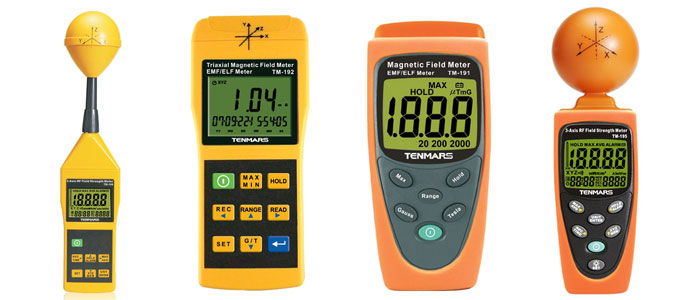Introduction: Electromagnetic fields (EMFs) are pervasive in modern society, emanating from various sources such as electrical power lines, electronic devices, communication networks, and industrial equipment. Measuring EMFs is essential for assessing exposure levels, ensuring regulatory compliance, and evaluating potential health risks associated with electromagnetic radiation. In this comprehensive guide, we delve into the principles, methods, and considerations involved in measuring electromagnetic fields, providing valuable insights for engineers, scientists, and health professionals.
- Understanding Electromagnetic Fields: Electromagnetic fields consist of electric and magnetic fields that oscillate in space and time, carrying energy and information through the interaction of electric charges and magnetic dipoles. EMFs are characterized by their frequency, wavelength, amplitude, and polarization, with different frequency ranges corresponding to distinct regions of the electromagnetic spectrum, such as radiofrequency (RF), microwave, infrared, visible light, ultraviolet, X-ray, and gamma-ray radiation.
- Types of Electromagnetic Field Measurements: Electromagnetic field measurements encompass a wide range of parameters, including electric field strength, magnetic field flux density, power density, frequency spectrum, modulation characteristics, and polarization orientation. Measurement techniques vary depending on the specific requirements of the application, such as environmental monitoring, occupational safety, electromagnetic compatibility (EMC) testing, and biomedical research.
- Instrumentation for EMF Measurements: A variety of instruments and devices are available for measuring electromagnetic fields, ranging from simple handheld meters to sophisticated laboratory-grade equipment. Common instruments include electric field meters, magnetic field meters, spectrum analyzers, RF power meters, dosimeters, and probes for near-field and far-field measurements. These instruments utilize different sensing technologies, such as electric field antennas, magnetic field sensors, and semiconductor detectors, to capture and quantify electromagnetic radiation.
- Measurement Standards and Guidelines: International organizations, regulatory agencies, and standards bodies establish guidelines and regulations for EMF exposure limits and measurement procedures to ensure public safety and environmental protection. Organizations such as the International Commission on Non-Ionizing Radiation Protection (ICNIRP), the Institute of Electrical and Electronics Engineers (IEEE), and national regulatory agencies publish standards and guidelines for EMF measurements, including reference levels, measurement protocols, and safety thresholds.
- Measurement Techniques and Procedures: Electromagnetic field measurements involve systematic procedures for surveying, monitoring, and assessing EMF levels in different environments and scenarios. Field measurements may include site surveys, point measurements, area mapping, and time-series monitoring to capture variations in EMF levels over space and time. Calibration of measurement instruments, environmental factors, and measurement uncertainties must be taken into account to ensure accurate and reliable results.
- Occupational and Environmental Monitoring: Occupational and environmental monitoring of electromagnetic fields is conducted to evaluate exposure levels in workplaces, residential areas, public spaces, and sensitive environments. Occupational exposure assessments are performed in compliance with occupational safety regulations to protect workers from excessive EMF exposure in industrial settings, such as power plants, telecommunications facilities, and medical facilities. Environmental monitoring assesses EMF levels in the natural environment, urban areas, and near EMF-emitting sources to identify potential hotspots and mitigate risks to public health and safety.
- Electromagnetic Compatibility Testing: Electromagnetic compatibility (EMC) testing is conducted to assess the electromagnetic interference (EMI) potential of electronic devices, equipment, and systems and ensure their reliable operation in the presence of electromagnetic fields. EMC testing involves measuring radiated emissions, conducted emissions, immunity levels, and susceptibility to external electromagnetic disturbances according to international EMC standards and regulations. Compliance with EMC requirements is essential for product certification, regulatory approval, and market access.
- Biomedical and Health Effects Research: Biomedical research investigates the potential health effects of electromagnetic fields on biological systems, including human health risks associated with EMF exposure. Epidemiological studies, laboratory experiments, and animal models are used to assess the relationship between EMF exposure and adverse health outcomes, such as cancer, neurodegenerative diseases, reproductive effects, and electromagnetic hypersensitivity (EHS). Dosimetry studies quantify EMF absorption and tissue exposure levels to correlate with biological effects and establish exposure guidelines for protecting public health.
- Risk Communication and Public Awareness: Effective risk communication and public awareness campaigns are essential for informing stakeholders, raising awareness, and addressing concerns about electromagnetic field exposure and potential health risks. Educational initiatives, outreach programs, and media campaigns provide accurate information, dispel misconceptions, and empower individuals to make informed decisions about EMF exposure mitigation, risk reduction strategies, and precautionary measures.
- Emerging Technologies and Future Trends: Advances in technology, such as 5G wireless networks, Internet of Things (IoT) devices, and electric vehicle (EV) charging infrastructure, are driving new challenges and opportunities in electromagnetic field measurement and management. Emerging technologies, such as real-time monitoring systems, wearable sensors, and predictive modeling tools, offer innovative solutions for monitoring, analyzing, and mitigating EMF exposure in diverse applications and environments.
Conclusion: Measuring electromagnetic fields is a multidisciplinary endeavor that combines principles of physics, engineering, environmental science, and public health to assess exposure levels, ensure regulatory compliance, and protect human health and safety. By understanding the principles, methods, and considerations involved in EMF measurements, engineers, scientists, and health professionals can effectively evaluate EMF risks, implement appropriate mitigation strategies, and promote responsible use of electromagnetic technologies. Through collaboration, innovation, and informed decision-making, we can navigate the complexities of electromagnetic fields and harness their benefits while minimizing potential risks to society and the environment.
